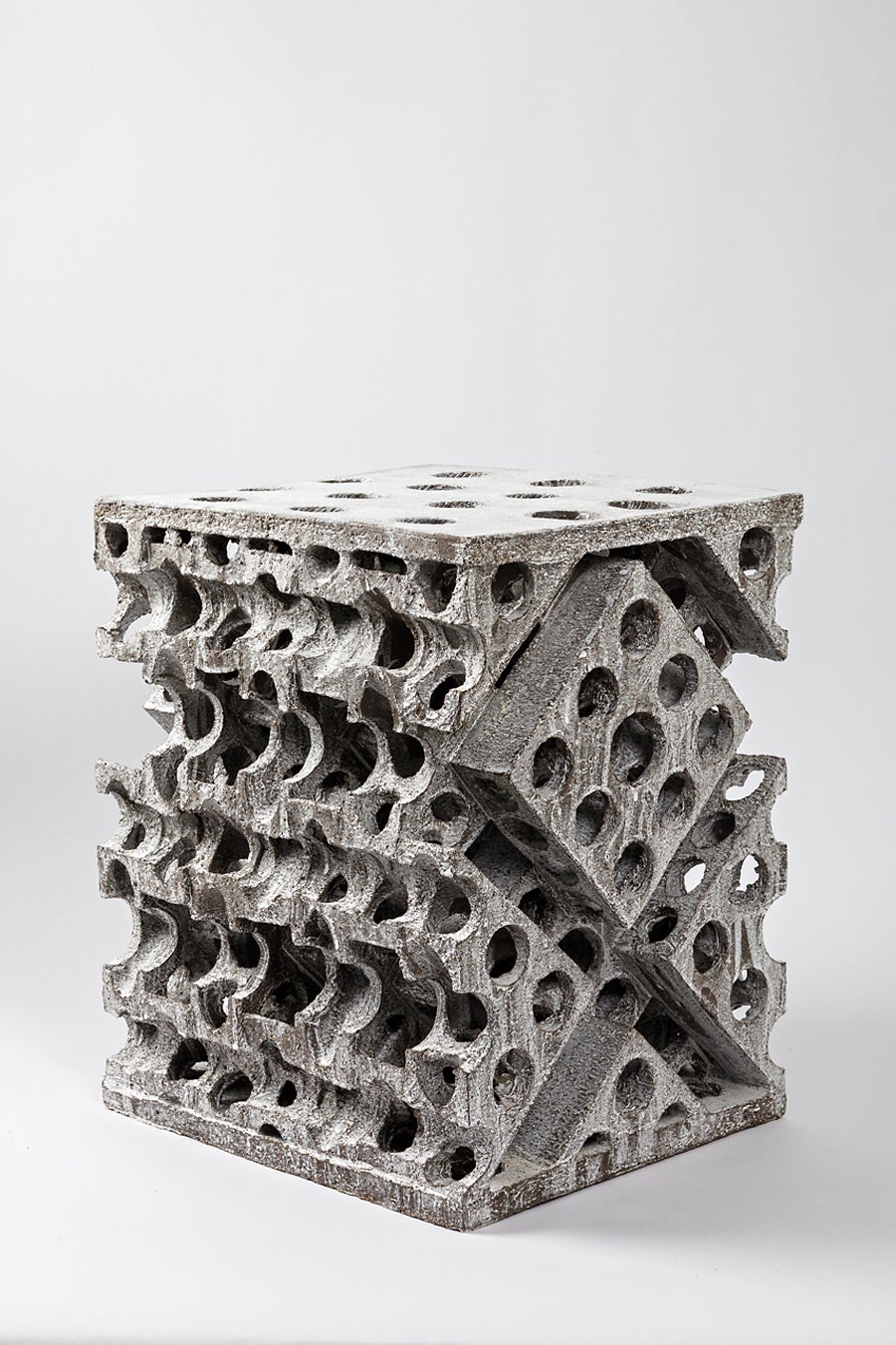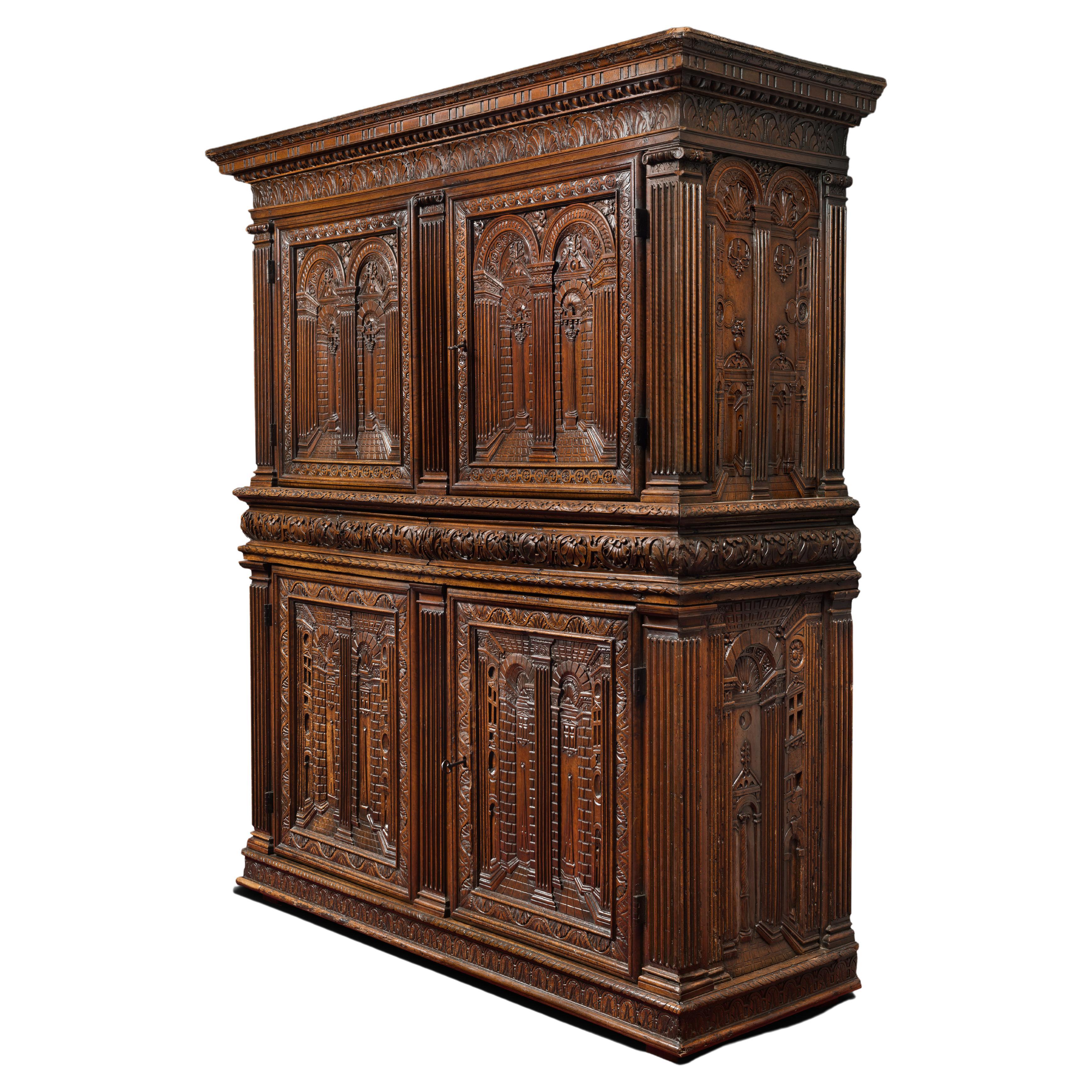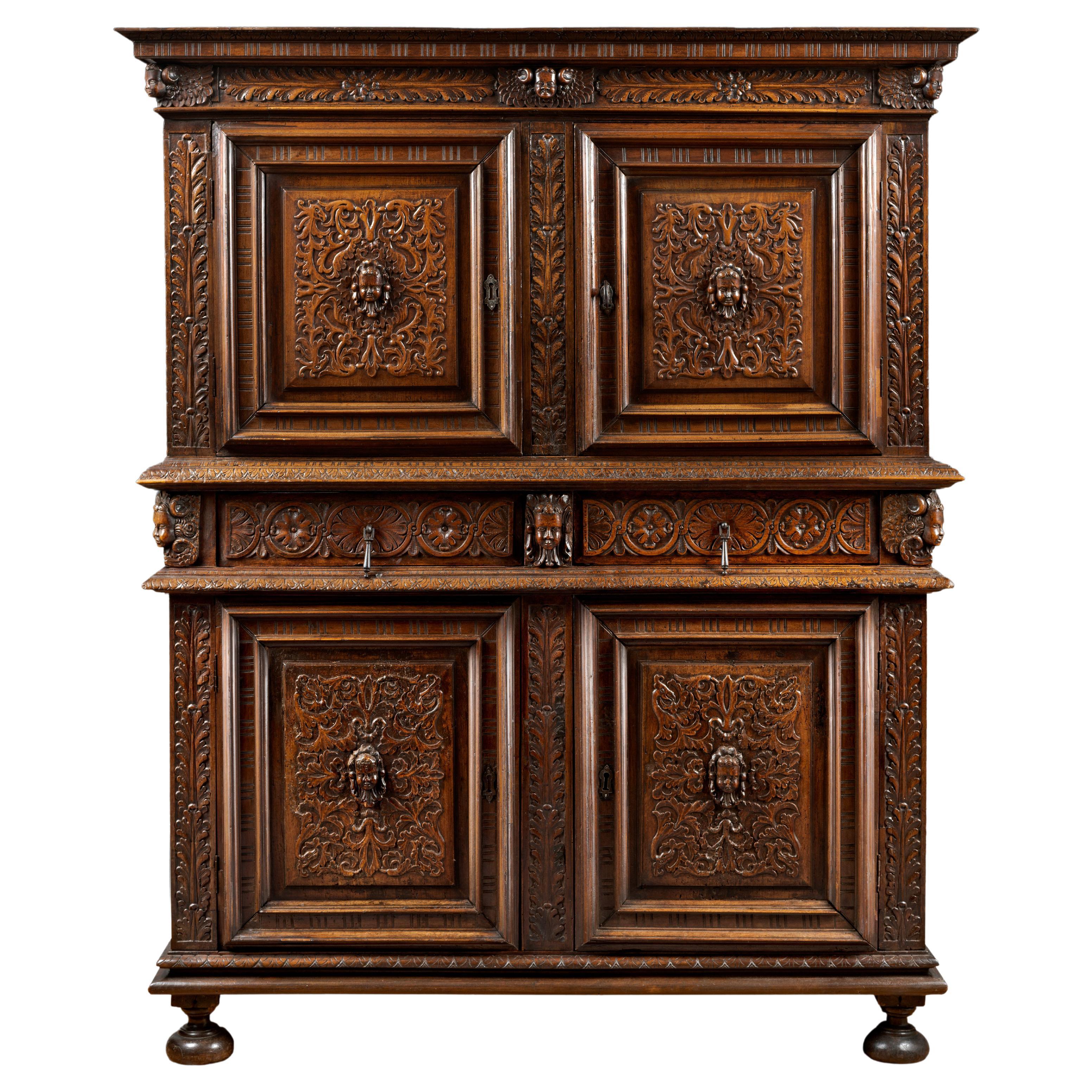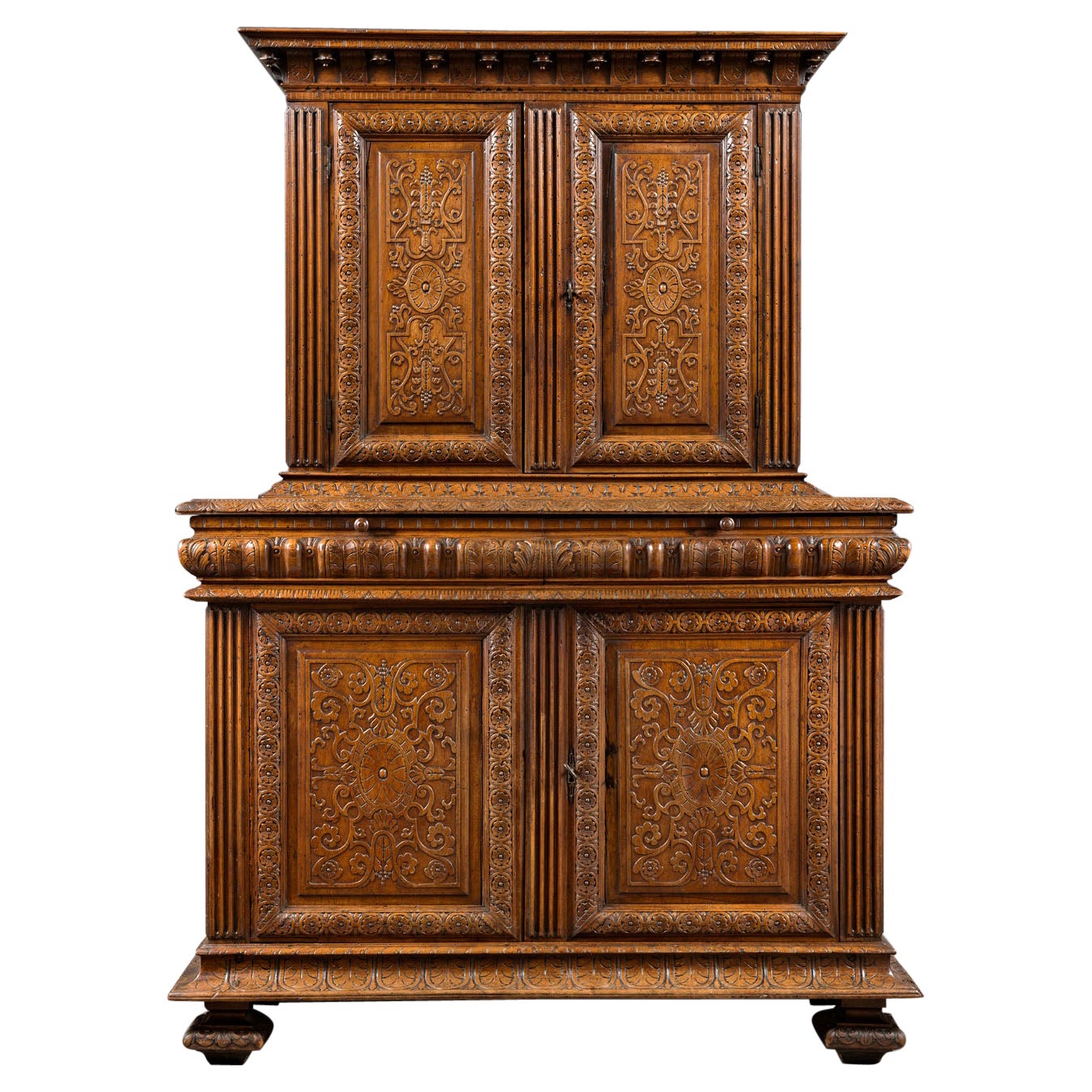Items Similar to Renaissance Cabinet form Lyon 'France'
Want more images or videos?
Request additional images or videos from the seller
1 of 6
Renaissance Cabinet form Lyon 'France'
About the Item
Condition : Partly dating from the Renaissance. The backs and the drawer’s insides have been re-done.
Historical background
The 16th century is a prosperous period for Lyon. The several fairs held in the city assure an economic vitality as well as a position of European crossroad. The royal court and many talented artists sojourn in this city thus promoting artistic creation. The thriving Lyon printing industry broadcasts models from the most influent and innovative artists. Those models are absorbed, revisited, transformed by Lyon workshops.
This is also during the 16th century that the city of Lyon re-discover its glorious antic past. Classical Antiquity gives the city fresh air to breathe with a new ornamental repertoire, interlacings, laurel leaves, choux bourguignons, palm leaves, spokes of heart, putti and grotesques.
These motifs can be seen on cabinet-makers’ and wood-carvers’ production. Artisans uses ornamental techniques similar to engraving’s giving a true identity to Lyon’s furnishing.
Furthermore Lyon’s cabinet-makers renew the furnishing’s structure using Antic architectural vocabulary first updated by Italian artists. This classical language may have been boosted by Sebastiano Serlio’s presence in Lyon. Likewise, Philibert de l’Orme, architect born in Lyon, travels to Rome to get acquainted with classical architecture.
While these references to Antiquity are common to all of Europe, Lyon distinguishes itself by using Antic concepts of balance and structure and by not being to literal, dismissing columns and pediments. The final result is perfectly harmonious and appears less architectural than in other regions.
Description
This is a two bodies cabinet with a recessed upper body. It opens with four door-leaves and two drawers inside the belt. The cabinet stands on a moulded and leafy base. The cabinet’s perfectly mastered architectural design and the balance of proportions are remarkable.
The cabinet’s structure is cleverly broke down. Horizontally the two bodies are divided by the two drawers belt. Vertically the four door-leaves are framed by jambs enriched with palm-leaves, choux bourguignons, flowers and blackened wood cartouches.
The two lower-body door-leaves are inserted in a mitre-cut assembled moulded frame and are ornated with symmetrical interlacings and vegetal scrolls. From those curls appear stylized birds’ heads centred by a chou bourguignon.
Both drawers are adorned with fruit garlands. A console separates the drawers.
The upper-body door-leaves are carved with leafy interlacings centred by a female mask.
The side panels are carved with a radiating rose decor for the upper-body and leafy blackened wood for the lower-body. The jambs are enriched by laurel frieze and an interlacing decor adorns the belt.
The care given to the lateral panels’ decor testifies the refinement of this cabinet.
The cabinet is topped by a protruding cornice carved with two palm-leaves friezes highlighted by two fusarolles. Two winged putti’s heads consoles and one female mask console support the cornice.
This cabinet’s decor shows a remarkable quality of execution and an amazing diversity. Friezes, panels, masks are all individualized. The refinement of the ornaments is anything but dull with reliefs producing light and shadow effects animating the panels’ surface. No doubt this sumptuous cabinet has been delivered by a skilled artisan.
With this perfectly harmonious cabinet are united an architectural structure and an engraving-style inspired decor. Those elements are typical of the school of Lyon between 1540 and 1570.
Literature
BOCCADOR Jacqueline, Le Mobilier français du Moyen Age à la Renaissance, Éditions d’art Monelle Hayot, 1988
THIRION Jacques, Le Mobilier du Moyen Age et de la Renaissance en France, Edition Faton, 1998
VIRASSAMYNAÏKEN Ludmila (dir.), Arts et Humanisme, Lyon Renaissance, Somogy éditions d’arts, Paris, 2015.
- Dimensions:Height: 82.68 in (210 cm)Width: 59.85 in (152 cm)Depth: 20.87 in (53 cm)
- Style:Renaissance (Of the Period)
- Materials and Techniques:
- Place of Origin:
- Period:
- Date of Manufacture:Second Half of the 16th Century
- Condition:Replacements made: Partly dating from the Renaissance. The backs and the drawer’s insides have been re-done.
- Seller Location:Saint-Ouen, FR
- Reference Number:1stDibs: LU3115327198182

About the Seller
5.0
Vetted Seller
These experienced sellers undergo a comprehensive evaluation by our team of in-house experts.
Established in 2016
1stDibs seller since 2017
156 sales on 1stDibs
Typical response time: 8 hours
- ShippingRetrieving quote...Ships From: Saint-Ouen, France
- Return PolicyThis item cannot be returned.
More From This SellerView All
- Important Renaissance Cabinet from Lyon 'France' with a Decor of PerspectivesLocated in Saint-Ouen, FRAs soon as 1540 France's second Renaissance is in the making, intimately linked to the rediscovery of the Antique world. The development of the printing and engraving industry allows the spread of artworks and models in many cities and countries. The Italian influence can be perceived in every artistic field. While the French king entrust the most talented Italian artists with major projects such as Il Rosso or Primaticcio in Fontainebleau, French artists also travel to Italy to form themselves to this new style. In Italy they get acquainted with the work of Leo Battista Alberti the first to theorize perspective (De Pictura, 1435-36) and architecture (De re oedificatoria, 1541). Those two publications would have a revolutionary impact on arts. Furniture is marked by the work of the most famous Italian architects of the time as well as French architects. Indeed Philibert de l'Orme competes with Alberti and by the end of his life publishes several treaties including one devoted to a theory of architecture (1567). Unfortunately he would not live to complete the second volume. In this treaty he expresses his interest for mathematical norms applied to architecture, copied from the Antique. His journeys in Italy allowed him to accumulate the most sophisticated references. Jean Bullant, another architect of great talent also theorizes his practice. He establishes rules characterizing Greco-Roman art staying faithful to Vitruvius. Following this new inspiration the structure of furniture evolves. From then on appear columns, capitals, cornices, friezes and architraves. The ornamentation uses this inspiration as well with egg-and-dart, palm leaf and rose adorning the most beautiful pieces. In Lyon, crossroad where meet merchants from everywhere those new experiments are welcomed. Lyon florishing printing industry allows the spreading of models and treaties essential to the artist's work. Thus the first publication of Vitruvius' De Architectura in France would be printed in Lyon in 1532. Artists from Lyon rediscover and familiarize themselves with the Antique knowledge very early. They adopt those new ideas and use them in their own creations. Lyon cabinet-makers re interpret Antique architecture and Italian Renaissance palaces to give their pieces a pure and harmonious architectural structure. Grooved pilasters are particularly favored. They are topped by capitals of diverse orders always respecting the sequencing with simpler ones for the lower levels and the richest ones on the higher levels. As for the ornamentation, one of the great distinctiveness of Lyon workshops remains the architectural perspective illusions, drawing inspiration from Tuscany. True masterpiece of the Second French Renaissance this important cabinet illustrates Lyon workshops' taste for fine Italian architecture inspired by Antiquity. An architectural perspective of great quality is treated in symmetry on each panel. This two-bodied cabinet without recess stands on four rectangular feet. The base comprises a molding, a palm leaf frieze and is bordered by a braid. The lower body is divided by three grooved pilasters with Tuscan capitals framing two door-leaves. The two panels are encircled by a moudled frame with palm leaves. They are finely carved with a decor of fantasized architecture depicting an Italian Renaissance palace erected symmetrically on each side of a grooved pilaster. On the ground floor a door opens through a stilted arch while the stories are opened with mullioned windows, dormers and occuli. Two large pegged-boss cladded pillars support the entablature enriched by a palm leaf frieze upon which stands an arch whose coffered intrados is centred by a rose. Behind this arch a pyramid appears, standing in front of a second facade with a window topped by a broken curvilinear pediment under a cul-de-four with a shell. The checker flooring gives depth to the low-reliefs creating vanishing points structuring the panels and guiding the eye of the observer. A thin laurel braid highlights the belt of the cabinet where are located two drawers. Their facades are adorned by palm leaves in hoops. The upper body is encircled with palm leaves. The same ternary division as in the lower body appears. However, the pilasters are topped by Ionic capitals with volutes and egg-and-dart. The door-leaves are framed with flowers. On the panels the artist has designed another architectural decor. On the foreground open two arches on top of grooved pilasters with rectangular capitals adorned with palm leaves. The arches are enriched with braids and the coffered intrados bears a decor of roses. The spandrels also bear a flower decor. In the background another arcature hosts a fluted grooved column topped with double basket acanthus capital, characteristic of Corinthian order. The triangular pediment is interrupted by a choux bourguignon. A large cornice crowns the cabinet. It stands on pilasters and forms an entablature comprising a palm leaf frieze and an egg-and-dart, triglyph and palm leaf cornice. The cabinet's sides have also been carefully considered. The lower body's panels are enriched with an arch rising above a broken pediment portico hosting a twisted column. Flowers garnish the spandrels. An architectural facade completes the decor. The upper body's panels present two arches supported by a facade opened with dormers and mullioned windows as well as cartouches (one bears the inscription 1580 dating the cabinet) suggesting the interior of an Italian Renaissance palace, confirmed by the chandeliers. The flooring leads our gaze to a second arch with a broken curvilinear pediment where stands a flower vase. This arch opens onto a perspective of another facade along a road. Inside the cabinet, on the lower body door-leaves appear two designs. On the right door is depicted a Crucifixion. Saint Mary and Saint John flank the Christ on the cross. In the bottom part is inscribed « Dure uiator abis nihil haec spectacula curas / Pendenti cum sis unica cura Deo. / Tota suo moriente dolet natura Magistro. / Nil qui solus eras caussa dolenda doles. ». The signature [Christoff Swartz Monachiensis pinx[it] / Ioa[nnes] Sadeler sculp[it]] tells us it was made by Johan Sadeler I (1550-1600) after Christoph Schwartz (1548-1592). This engraving belongs to an ensemble depicting the Passion of Christ Johan Sadeler executed in 1589 after an altar piece painted by Christoph Schwartz for the private chapel of Renée of Loraine, wife of Duke William V of Bavaria. This altar piece made of nine copper panels has been destroyed during the 19th century. The Crucifixion panel once in the centre of the altar piece is the only one that survived and is today kept in Munich's Alte Pinakothek. On the left door appears Saint Francis receiving the stigmata. The inscription says : « Signastidomine Servum Tuum. Franciscum. Signis Redemptionis Nostrae ». This Renaissance cabinet with an architectural decor appearing as much in the structure faithful to Antique rules...Category
Antique 16th Century European Renaissance Cabinets
MaterialsWalnut
- Renaissance Cabinet from Burgundy or Lyon RegionLocated in Saint-Ouen, FRRenaissance cabinet from Burgundy Or Lyon Region Origin : Burgundy Or Lyon, France Period : Second Half 16th Century, C. 1580 Height : 209cm Length : 184cm Depth : 71cm Good condition Walnut wood, original keys and keyholes Around the middle of the 16th century the conception and ornamentation of French furniture evolves. The start of major building projects, such as the castle of Fontainebleau, gives artists a new impulse. Inventive and rich formulas are developed there, before spreading to all of Europe thanks to engravings and printed leaflets. Furthermore, Italian artists working on such construction sites bring French artists and patrons a renewed taste for the Antique. Regarding the art of furnitures, the most complex scenes and figures are drawn from illustrated books, ornament and emblem compendiums and engraving compilations. Rather than copying those images the artisans feed their inspiration and decline the motifs in numerous variations. The ornamental grammar marks a return to the Antique : palm leaf, acanthus, egg-and-dart, greek, scroll, fluted pilaster… It is in Primaticcio’s and Il Rosso’s stuccos made around 1540-1550 that we have to look for the origin of leather cut-outs, masks, chimaeras, harpies, sheathed figures, fruit and flower garlands that soon enrich every pieces of French furniture. The structure of the pieces of furniture also evolve thanks to the re discovery of Antique architectures, rigorously used as a model. This cabinet presents an imposing structure and a rich and original decor exemplifying the production of the late 16th century, infused with Italian, Antique and Fontainebleau influences. It stands on a moulded base ornate with palm leaves. It opens with four door-leaves and two drawers in the belt. Six whimsical terms divide the facade. The lower body is horizontally divided by three sheathed female terms. The two standing on the lateral posts are topped with fruits while the body is covered by acanthus leaves carved with precision, belted at the waist. The term standing on the central door-jamb is crowned with laurel leaves and is draped in the Antique fashion. A wincing mask hides the key hole. The two door-leaves are centred by a beautiful mask carved in a strong relief. They wear stylised feathered headdress and are set on draperies. Straps, leather scrolls, acanthus leaves and a shell are spread around the masks. The recessed panels are secured in frames ornate with acanthus leaves. The belt is flanked by two large mouldings enriched with variations of acanthus leaves. The drawers are carved with choux bourguignons and palm leaf motifs minutely executed. The consoles between each drawer bear tormented wincing masks, showing horns as if they were fauns or imps. The upper body is framed by two male terms characterised by a strong and nervous musculature, their manhood hidden by drapes secured thanks to a winged lion head. The term on the left appears to be younger and is wincing while the one on the right has a beard. The central female term brings contrast with her youth and sensuality. As it is the case on the lower body, the key hole is hidden behind the mouth of a faun’s mask placed on the drapes barely covering the intimacy of the caryatid. The panels of the upper body present an idealised architecture comprising pilasters and sinuous broken pediments. The pilasters are flanked by two satyrs with goat legs. In the centre appears an important lion mask. The terms of the upper body support the cornice. The entablature carries palm leaves and roses alternating as well as an egg-and-dart frieze. The cornice is adorned with acanthus motifs. On the sides, the carving is executed flat. A central rose is surrounded by scrolls, flowers and choux bourguignons. We can admire the variety of the elements employed. The artist vary with great genius many different ornamental motifs : palm leaf, egg-and-dart, laurel leaf, roses, scrolls … But the artist went even further as each profile and each face is individualised and presents different features. You can take a look at the faces of the satyrs flanking the upper body’s panels. The talent of the artist is undeniable. It makes no doubt the patron who commissioned this cabinet was an aesthete looking for the greatest quality. The artist who authored this cabinet had a great mastery of composition both in the general design and in the individual panels. They probably drew inspiration from engravings and drawings made especially for the making of this piece of furniture or not. They seem to be familiar with the style of Jacques Androuet du Cerceau. Indeed, we can find in Du Cerceau’s engravings the same juxtapositions of leather cut-outs, masks and fruits. The terms and caryatids used on the facade could very well be inspired by his work as well. The cabinet-maker was also undoubtedly observant of Hugues Sambin, the most famous cabinet-maker and sculptor in the Burgundy of the time. Like Du Cerceau, Sambin left an important ensemble of models particularly useful for the design of cabinets. His publication De l’Oeuvre de la diversité des termes dont on use en architecture (1572) was an essential book for every artisan. All the motifs testify of the artisan’s high knowledge of forms as well as the precision of their tools : super imposition of ornamental elements, foliages, architectural cut-outs, flat and high reliefs alternating, palm leaves inscribed in circular spaces, wincing faces. It is also a testimony of the artisan’s familiarity with Italian and Fontainebleau productions. Because of the proficiency of the cabinet-maker in so many different models, this cabinet truly is a master-piece authored by the hand of an authentic master. The generous carvings executed with great rigour and virtuosity evoke an origin close to Burgundy and Lyon workshops. This cabinet was made by a master of the region during the Second French Renaissance. Literature BOCCADOR Jacqueline, Le mobilier français du Moyen-Âge à la Renaissance, Édition d’art Morelle Mayot, 1996 BOS Agnès (dir.), Mobilier du Moyen âge et de la Renaissance, La collection du musée du Louvre, Louvre éditions...Category
Antique 16th Century Renaissance Cabinets
MaterialsWalnut
- Small Renaissance Cabinet from LyonLocated in Saint-Ouen, FRSmall renaissance cabinet from Lyon. ORIGIN: FRANCE, SCHOOL OF LYON PERIOD: 16th CENTURY Height:151cm Depth: 120cm Length: 54cm Walnut ...Category
Antique 16th Century Cabinets
MaterialsWalnut
- Exceptional Renaissance Cabinet from LyonLocated in Saint-Ouen, FRExceptional Renaissance Cabinet from Lyon Origin: Lyon, France Period: 1540-1580, Second French Renaissance Measures: Height: 188 cm Length: 132 cm ...Category
Antique 16th Century Cabinets
MaterialsWalnut
- French Renaissance Cabinet with PerspectivesLocated in Saint-Ouen, FRThis Renaissance Cabinet reveals the great mastery of the Lyon workshops which are at the origin of its realization. Sculptors and wood-carvers worked here in symbiosis to express an...Category
Antique 16th Century French Renaissance Cabinets
MaterialsWalnut
- 16th Century French Carved Renaissance CabinetLocated in Saint-Ouen, FRRare carved Renaissance cabinet Period : 2nd half 16th century, ca. 1570 Origin : France, Burgundy or Languedoc This cabinet embody the produ...Category
Antique 16th Century French Renaissance Cabinets
MaterialsWalnut
You May Also Like
- Renaissance CabinetLocated in Washington, DCA truly stunning cabinet with a rich patina. Made by a Swedish cabinetmaker in the early 19th century. The paint on the inside and the outside is all original. Original hardware includes the hinges, locks, key, straps. Intricate carved paneling.Category
Antique Early 19th Century Swedish Renaissance Cupboards
MaterialsIron
- Renaissance Style Cabinet, France, Circa 1870Located in PARIS, FRAn outstanding carved cabinet in the Renaissance style. The upper part consists in two stages with arcades, divided in six compartments by rich columns with Corinthian capitals, and topped by a carved entablature. The lower part opens with three doors, ornated with masks, hybrid figures and foliates, and relies on four strong feet. This cabinet, probably executed for an amateur or a collector, is a perfect model for the neo-Renaissance style, that rose in the 1830’s, in France with the designers Claude-Aimé Chenavard (1798-1838) and Michel Liénard (1810-1870). It came some years after the Gothic Revival, but met a longer success during the 19th century (at the Expositions des Produits de l’industrie in 1844 and 1849, and at the Universal Exhibitions in 1855, 1867 and 1878). Inspiration was found in the French Renaissance, more specifically in the art of Henri II’s reign, and cabinet-makers used dark carved...Category
Antique 1870s French Renaissance Cabinets
MaterialsWood
- Figural Renaissance cabinet, France, around 1870.Located in Chorzów, PLFigural Renaissance cabinet, France, around 1870. Very good condition. Wood: walnut dimensions: width 131 cm x height 175 cm x depth 52 cmCategory
Antique 1870s French Renaissance Cabinets
MaterialsWalnut
- 19th Century, French Renaissance Walnut CabinetLocated in Hixson, TNAn astounding French Renaissance walnut cabinet with superb detailed carvings. This piece is not only striking but its large. The top has a v...Category
Antique 1840s French Renaissance Cabinets
MaterialsWalnut
- Cabinet in the Renaissance Style, France, 1870Located in Chorzów, PLCabinet in the Renaissance style, France, 1870. Very good condition. Wood: Walnut Dimensions: height 233 cm, width 64 cm, depth 62 cm.Category
Antique 1870s French Renaissance Cabinets
MaterialsWalnut
- Italian Renaissance Walnut CabinetLocated in Essex, MAWith a rectangular top with molded edge over a frieze with two drawers flanked by three acanthus carved corbel shaped drawers, pair cabinet doors below wi...Category
Antique 1650s Italian Renaissance Cabinets
MaterialsWalnut
Recently Viewed
View AllMore Ways To Browse
Antique Forms
Antique Form
Renaissance Renaissance
Antique Renaissance
Furniture In The Renaissance
Form Architects
Antique Renaissance Furniture
Dating Antique French Furniture
Antique Body Forms
Form Editions
Architect France
Flowers Cabinet
Cabinet Flower
Renaissance French Renaissance
Renaissance France
French Garlands
Recessed Cabinet
Cabinet Amazing





